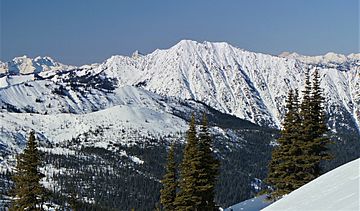Jim Hill Mountain facts for kids
Quick facts for kids Jim Hill Mountain |
|
|---|---|

Jim Hill Mountain, southeast aspect
|
|
| Highest point | |
| Elevation | 6,765 ft (2,062 m) |
| Prominence | 2,085 ft (636 m) |
| Isolation | 3.82 mi (6.15 km) |
| Parent peak | Bulls Tooth (6,840 ft) |
| Geography | |
| Location | Chelan County Washington state, U.S. |
| Parent range | Chiwaukum Mountains Wenatchee Mountains Cascade Range |
| Topo map | USGS Stevens Pass |
| Climbing | |
| Easiest route | Scrambling |
Jim Hill Mountain is a tall mountain peak in Chelan County, Washington state. It stands about 6,765 feet (2,062 meters) high. The mountain is located about 3.5 miles (5.6 km) east of Stevens Pass. It sits on the edge of the Alpine Lakes Wilderness area. The land around it is managed by the Okanogan-Wenatchee National Forest.
Jim Hill Mountain is part of the Chiwaukum Mountains, which are a smaller group of mountains within the larger Cascade Range. A nearby mountain, Bulls Tooth, is even taller and is about 3.8 miles (6.1 km) to the south. Water from the mountain flows into Nason Creek, which then joins the Wenatchee River. Jim Hill Mountain is just south of the eastern entrance to the Cascade Tunnel. This tunnel was built by the Great Northern Railway.
Why is it called Jim Hill Mountain?
This mountain was named by Albert Hale Sylvester. He chose the name to honor James J. Hill (1838–1916). James J. Hill was a very important person who led the Great Northern Railway. People called him "The Empire Builder" because he helped build so much. This nickname also inspired the name of a famous passenger train, the Empire Builder. This train travels from Seattle to Chicago and passes right below Jim Hill Mountain.
Weather and Climate Around the Mountain
Jim Hill Mountain is in a place with a marine west coast climate. This means it gets a lot of moisture from the Pacific Ocean. Most weather systems come from the Pacific and move northeast towards the Cascade Mountains.
When these weather systems hit the tall Cascade Mountains, the air is forced to rise. As the air goes higher, it cools down and drops its moisture. This causes a lot of rain or snow to fall on the western side of the Cascades. This process is called Orographic lift.
During winter, it's usually cloudy, and there's a lot of snowfall. However, in summer, high-pressure systems over the Pacific Ocean often bring clear skies. Because of the ocean's influence, the snow here can be wet and heavy. This can sometimes lead to avalanche danger. A very large avalanche, known as the 1910 Wellington avalanche, happened about 7 miles (11 km) west-southwest of Jim Hill Mountain.
How the Mountains Were Formed
The Alpine Lakes Wilderness area, where Jim Hill Mountain is located, has very rugged land. You can see sharp peaks, long ridges, deep valleys carved by glaciers, and tall granite walls. There are also more than 700 mountain lakes scattered around.
Many years ago, big geological events shaped this area. These events created the varied landscape and the huge changes in elevation you see in the Cascade Range. For example, Glacier Peak, a large volcano called a stratovolcano, started forming about 26.3 miles (42.3 km) north of Jim Hill Mountain during the middle of the Pleistocene era.
During the Pleistocene period, which was over two million years ago, glaciers moved back and forth many times. As they moved, they scraped away the land and left behind piles of rock. The last time the glaciers retreated from the Alpine Lakes area was about 14,000 years ago. They had moved north of the Canada–US border by 10,000 years ago. The valleys in this area have a "U" shape. This shape was created by these ancient glaciers. The combination of land being pushed up (orogeny) and cracks forming in the Earth's crust (faulting), along with the action of glaciers, has created the tall peaks and deep valleys of the Alpine Lakes Wilderness.



